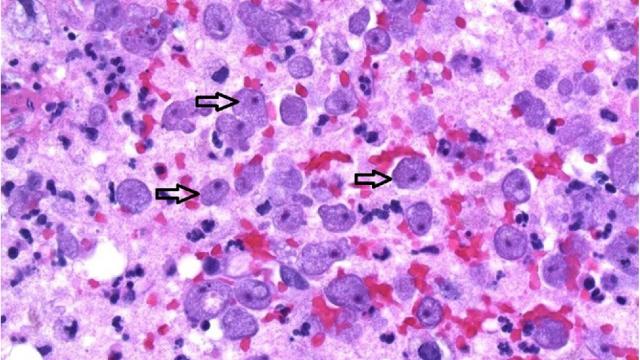A 68-year-old Seattle woman who died after contracting a rare brain-eating amoeba used regular tap water to rinse her sinuses, according to new research.
As noted in a new International Journal of Infectious Diseases case study, the infection was initially misdiagnosed as a brain tumour. During surgery to remove the suspected tumour, the lead neurosurgeon, Charles Cobbs from Seattle’s Swedish Medical Center, was taken aback by the extent of the brain damage. So he extracted a sample for further testing.
“When I operated on this lady, a section of her brain about the size of a golf ball was bloody mush,” Cobbs told the Seattle Times. “There were these amoeba all over the place just eating brain cells. We didn’t have any clue what was going on, but when we got the actual tissue we could see it was the amoeba.”
Indeed, the ensuing biopsy report showed that the woman had been infected with a rare brain-eating amoeba called Balamuthia mandrillaris. These sorts of infections are quite rare, but what’s unique about this incident is that it’s the “first case of Balamuthia mandrillaris brain infection suspected from nasal lavage,” according to the case study, which was authored by Swedish scientists and the doctors who worked on the case, Cobbs included.
By nasal lavage the researchers are referring to the use of a neti pot — a teapot-shaped device that relieves sinus pressure by flushing water through the nasal cavity. The researchers said the patient used tap water filtered through a store-bought water filter, instead of the recommended boiled or saline water.
As a user of neti pots, this comes as a shock to me. I admittedly did not know that boiled or saline water is supposed to be used instead of tap water — and I suspect this comes as a surprise to a lot of other people, as well.
B. mandrillaris is a free-living amoeba that lives in soil and freshwater. This single-celled organism is not to be confused with Naegleria fowleri, another brain-eating amoeba that also lives in freshwater. Unlike N. fowleri, however, which kills its human victims in a matter of days, the B. mandrillaris amoeba requires more time to inflict its damage. In this case, the woman lived for about a year after becoming infected, according to the report.
These amoebas traditionally live in the warm climates of South and Central America, but climate change may be opening up new habitats — including in northern US states like Washington. B. mandrillaris was first detected in 1986 in a mandrill monkey kept at San Diego Zoo. It was declared a distinct species in 1993, according to the report. Globally, only 200 infections have ever been recorded, of which 70 occurred in the United States. Alarmingly, the fatality rate is practically 100 per cent.
Normally, an extra effort is required to bring on an infection; it cannot be contracted by drinking contaminated water. In cases involving N. fowleri, for example, people have contracted the amoeba by jumping into a lake and having water shoot up their noses. In this case, however, it was the neti rinse device that delivered the amoebas, via infected tap water, into her nasal passages and into her olfactory nerves, the scientists said.
For this poor woman, who died from the brain infection this past February, the condition had first manifested as a skin rash on her nose. Not suspecting anything particularly unusual, her doctors diagnosed it as a rosacea, a common skin condition, with treatments lasting for about a year. It wasn’t until the woman suffered a stroke, and had CT scans done of her brain, that the brain tumour was diagnosed — or more accurately, misdiagnosed. The woman’s brain surgery and subsequent biopsy finally revealed the true nature of her condition.
“Despite aggressive anti-amoebic therapy, the patient’s condition continued to deteriorate,” noted the authors of the report. “Within one week she was more somnolent [sleepy] and then became comatose. Repeat CT imaging demonstrated further haemorrhage into the original resection cavity. At this point, the family decided to withdraw support.”
The patient died about a month after finally receiving the correct diagnosis.
Indeed, the incident shows how notoriously difficult it is to correctly diagnose this kind of infection. As the researchers noted in the case study, there’s still much to learn about the mode of and reasons for these infections, such as the influence of compromised immune systems, environmental factors, and genetics. In the meantime, the scientists recommend that doctors conduct amoeba testing in cases of nasal sores and ring-enhancing brain lesions.
Importantly, the scientists said we should not give up on neti pots, as the devices present a good way of getting nasal relief. As long as we wash the containers properly and use either boiled or saline water we should be OK.
